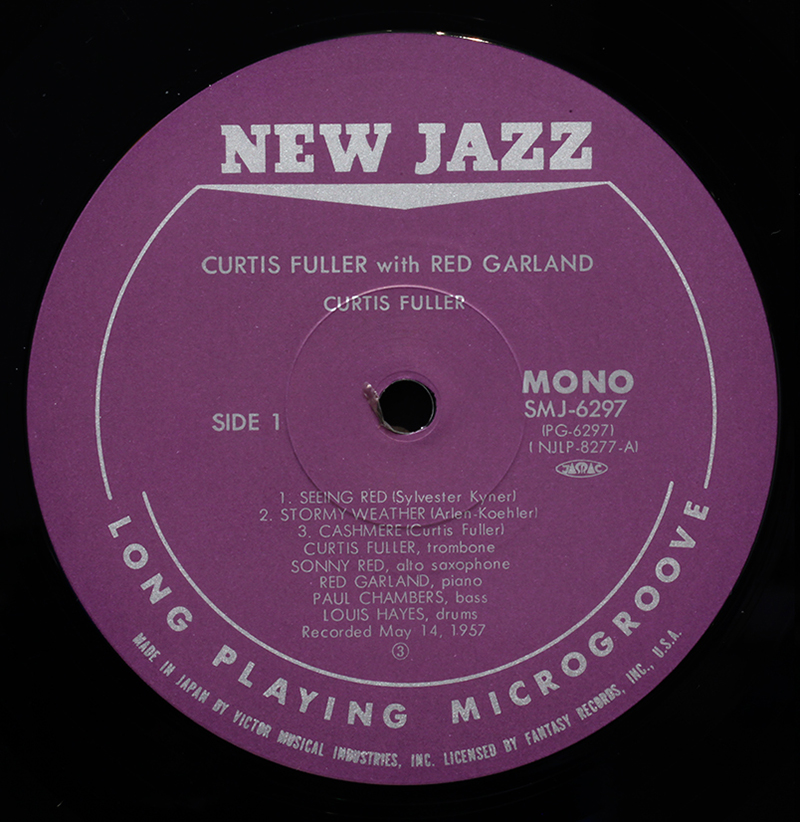Weinstock produced most of the Prestige sessions during the 50s. In the 60s, he would largely turn
that task over to others -- Chris Albertson, Ozzie Cadena (who originally put J. J. and Kai together), Esmond Edwards, Don Schlitten. Weinstock's production philosophy, as we know, was mostly hands off - create the open, spontaneous feel of a jam session. And as we've seen, it was a successful philosophy.
that task over to others -- Chris Albertson, Ozzie Cadena (who originally put J. J. and Kai together), Esmond Edwards, Don Schlitten. Weinstock's production philosophy, as we know, was mostly hands off - create the open, spontaneous feel of a jam session. And as we've seen, it was a successful philosophy.
Charles may have been a little more hands-on, which could explain why this session, three days after Fuller's debut, is so different.
The difference begins with the first cut. Paul Chambers has replaced Doug Watkins, and Watkins was a great bass player, but Paul Chambers was Paul Chambers. "Slenderella" (mislabeled "Cinderella" in the set notes) is one of two Sonny Red compositions, but Red may not have thought of starting it with a 30-second walking bass vamp that immediately lets you know this is going to be different. Or, I should say, immediately lets the musicians know there's going to be a new sound, because although "Slenderella" was recorded first, it wasn't first on the album as released.
Much has been made of the way J. J. Johnson introduced a new fluidity to the trombone, an instrument thought to be too unwieldy to handle the fast pace of bebop. Certainly there had been very good trombonists in the earlier days of jazz--Kid Ory, Glenn Miller, Tommy Dorsey, Trummy Young (whom Fuller nearly replaced in Louis Armstrong's group)--but bebop created a whole new set of demands. Curtis Fuller is often mentioned as Johnson's most accomplished successor, and he certainly shows it already, on this early album. In "Slenderella," he sets himself some amazing challenges for fast fluid runs on the trombone, and meets them all.
:format(jpeg):mode_rgb():quality(90)/discogs-images/R-6525059-1421229654-4409.jpeg.jpg) The two standards on the session include Harold Arlen's beautiful and oft-parodied "Stormy Weather" (viz Ronny Graham: "Can't go on, all my nembutals are gone...Leonard Feather"). The mournful tone of this one has been indelibly set by Arlen's melody and Lena Horne's definitive version of it, so Fuller is called upon to trade in his bebop dexterity for sensitivity, and he does just that, starting from a haunting vamp by Chambers and Garland, never straying far from the melody, and taking most of the solo work on himself.
The two standards on the session include Harold Arlen's beautiful and oft-parodied "Stormy Weather" (viz Ronny Graham: "Can't go on, all my nembutals are gone...Leonard Feather"). The mournful tone of this one has been indelibly set by Arlen's melody and Lena Horne's definitive version of it, so Fuller is called upon to trade in his bebop dexterity for sensitivity, and he does just that, starting from a haunting vamp by Chambers and Garland, never straying far from the melody, and taking most of the solo work on himself.
And the Teddy Charles touch really asserts itself in the last cut of the day, and the last cut on the finished album, which is a Charles composition, "Roc and Troll." This is not the kind of thing that you'd have expected to hear at the Blue Bird Inn in Detroit. It's a whole different kind of challenge, and it really shows Fuller's and Garland's versatility. Sonny Red's solo takes it back to the
language of bebop, which is interesting in itself, and shows once again that the often-maligned head-solo-solo-solo-head structure of much small group jazz makes for some fascinating conversations between styles and approaches
language of bebop, which is interesting in itself, and shows once again that the often-maligned head-solo-solo-solo-head structure of much small group jazz makes for some fascinating conversations between styles and approaches
The session notes give this as the Curtis Fuller-Red Garland Quintet. The album cover tilts the credit a little more in favor of Fuller--Curtis Fuller with Red Garland. And for some reason, it was released on New Jazz--perhaps because it followed so closely on the heels of another Fuller album? But that wouldn't necessarily be a problem. Albums weren't always released in the order of their being made.



No comments:
Post a Comment